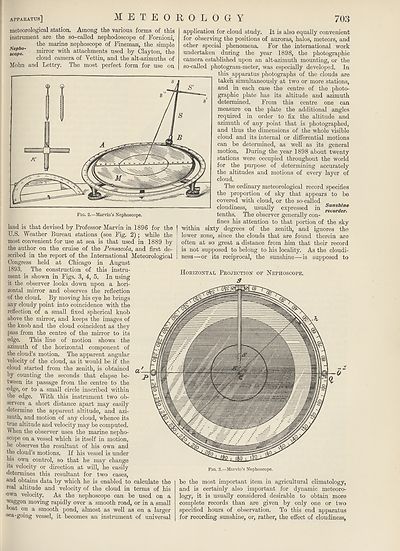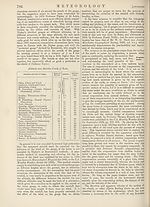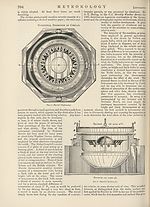New volumes of the Encyclopædia Britannica > Volume 30, K-MOR
(747) Page 703
Download files
Complete book:
Individual page:
Thumbnail gallery: Grid view | List view

apparatus]
METEOROLOGY
703
meteorological station. Among the various forms of this
instrument are the so-called nephodoscope of Fornioni,
the marine nephoscope of Fineman, the simple
scope' mirror attachments used by Clayton, the
cloud camera of Yettin, and the alt-azimuths of
Mohn and Lettry. The most perfect form for use on
Fig. 2.—Marvin’s Nephoscope.
land is that devised by Professor Marvin in 1896 for the
U.S. Weather Bureau stations (see Fig. 2); while the
most convenient for use at sea is that used in 1889 by
the author on the cruise of the Pensacola, and first de¬
scribed in the report of the International Meteorological
Congress held at Chicago in August
1893. The construction of this instru¬
ment is shown in Figs. 3, 4, 5. In using
it the observer looks down upon a hori¬
zontal mirror and observes the reflection
of the cloud. By moving his eye he brings
any cloudy point into coincidence with the
reflection of a small fixed spherical knob
above the mirror, and keeps the images of
the knob and the cloud coincident as they
pass from the centre of the mirror to its
edge. This line of motion shows the
azimuth of the horizontal component of
the cloud’s motion. The apparent angular
velocity of the cloud, as it would be if the
cloud started from the zenith, is obtained
by counting the seconds that elapse be¬
tween its passage from the centre to the
■edge, or to a small circle inscribed Avithin
the edge. With this instrument two ob¬
servers a short distance apart may easily
determine the apparent altitude, and azi¬
muth, and motion of any cloud, whence its
true altitude and velocity may be computed.
When the observer uses the marine nepho¬
scope on a vessel which is itself in motion,
he observes the resultant of his own and
the cloud’s motions. If his vessel is under
his own control, so that he may change
its velocity or direction at will, he easily
determines this resultant for two cases,
and obtains data by which he is enabled to calculate the
real altitude and velocity of the cloud in terms of his
own velocity. As the nephoscope can be used on a
waggon moving rapidly over a smooth road, or in a small
boat on a smooth pond, almost as well as on a larger
sea-going vessel, it becomes an instrument of universal
application for cloud study. It is also equally convenient
for observing the positions of auroras, halos, meteors, and
other special phenomena. For the international work
undertaken during the year 1898, the photographic
camera established upon an alt-azimuth mounting, or the
so-called photogram-meter, was especially developed. In
this apparatus photographs of the clouds are
taken simultaneously at two or more stations,
and in each case the centre of the photo¬
graphic plate has its altitude and azimuth
determined. From this centre one can
measure on the plate the additional angles
required in order to fix the altitude and
azimuth of any point that is photographed,
and thus the dimensions of the whole visible
cloud and its internal or differential motions
can be determined, as well as its general
motion. During the year 1898 about twenty
stations were occupied throughout the world
for the purpose of determining accurately
the altitudes and motions of every layer of
cloud.
The ordinary meteorological record specifies
the proportion of sky that appears to be
covered with cloud, or the so-called
cloudiness, usually expressed in ^.^order
tenths. The observer generally con¬
fines his attention to that portion of the sky
within sixty degrees of the zenith, and ignores the
lower zone, since the clouds that are found therein are
often at so great a distance from him that their record
is not supposed to belong to his locality. As the cloudi¬
ness—or its reciprocal, the sunshine—is supposed to
Horizontal Projection of Nephoscope.
Fig. 3.—Marvin’s Nephoscope.
be the most important item in agricultural climatology,
and is certainly also important for dynamic meteoro¬
logy, it is usually considered desirable to obtain more
complete records than are given by only one or two
specified hours of observation. To this end apparatus
for recording sunshine, or, rather, the effect of cloudiness,
METEOROLOGY
703
meteorological station. Among the various forms of this
instrument are the so-called nephodoscope of Fornioni,
the marine nephoscope of Fineman, the simple
scope' mirror attachments used by Clayton, the
cloud camera of Yettin, and the alt-azimuths of
Mohn and Lettry. The most perfect form for use on
Fig. 2.—Marvin’s Nephoscope.
land is that devised by Professor Marvin in 1896 for the
U.S. Weather Bureau stations (see Fig. 2); while the
most convenient for use at sea is that used in 1889 by
the author on the cruise of the Pensacola, and first de¬
scribed in the report of the International Meteorological
Congress held at Chicago in August
1893. The construction of this instru¬
ment is shown in Figs. 3, 4, 5. In using
it the observer looks down upon a hori¬
zontal mirror and observes the reflection
of the cloud. By moving his eye he brings
any cloudy point into coincidence with the
reflection of a small fixed spherical knob
above the mirror, and keeps the images of
the knob and the cloud coincident as they
pass from the centre of the mirror to its
edge. This line of motion shows the
azimuth of the horizontal component of
the cloud’s motion. The apparent angular
velocity of the cloud, as it would be if the
cloud started from the zenith, is obtained
by counting the seconds that elapse be¬
tween its passage from the centre to the
■edge, or to a small circle inscribed Avithin
the edge. With this instrument two ob¬
servers a short distance apart may easily
determine the apparent altitude, and azi¬
muth, and motion of any cloud, whence its
true altitude and velocity may be computed.
When the observer uses the marine nepho¬
scope on a vessel which is itself in motion,
he observes the resultant of his own and
the cloud’s motions. If his vessel is under
his own control, so that he may change
its velocity or direction at will, he easily
determines this resultant for two cases,
and obtains data by which he is enabled to calculate the
real altitude and velocity of the cloud in terms of his
own velocity. As the nephoscope can be used on a
waggon moving rapidly over a smooth road, or in a small
boat on a smooth pond, almost as well as on a larger
sea-going vessel, it becomes an instrument of universal
application for cloud study. It is also equally convenient
for observing the positions of auroras, halos, meteors, and
other special phenomena. For the international work
undertaken during the year 1898, the photographic
camera established upon an alt-azimuth mounting, or the
so-called photogram-meter, was especially developed. In
this apparatus photographs of the clouds are
taken simultaneously at two or more stations,
and in each case the centre of the photo¬
graphic plate has its altitude and azimuth
determined. From this centre one can
measure on the plate the additional angles
required in order to fix the altitude and
azimuth of any point that is photographed,
and thus the dimensions of the whole visible
cloud and its internal or differential motions
can be determined, as well as its general
motion. During the year 1898 about twenty
stations were occupied throughout the world
for the purpose of determining accurately
the altitudes and motions of every layer of
cloud.
The ordinary meteorological record specifies
the proportion of sky that appears to be
covered with cloud, or the so-called
cloudiness, usually expressed in ^.^order
tenths. The observer generally con¬
fines his attention to that portion of the sky
within sixty degrees of the zenith, and ignores the
lower zone, since the clouds that are found therein are
often at so great a distance from him that their record
is not supposed to belong to his locality. As the cloudi¬
ness—or its reciprocal, the sunshine—is supposed to
Horizontal Projection of Nephoscope.
Fig. 3.—Marvin’s Nephoscope.
be the most important item in agricultural climatology,
and is certainly also important for dynamic meteoro¬
logy, it is usually considered desirable to obtain more
complete records than are given by only one or two
specified hours of observation. To this end apparatus
for recording sunshine, or, rather, the effect of cloudiness,
Set display mode to:
![]() Universal Viewer |
Universal Viewer | ![]() Mirador |
Large image | Transcription
Mirador |
Large image | Transcription
Images and transcriptions on this page, including medium image downloads, may be used under the Creative Commons Attribution 4.0 International Licence unless otherwise stated. ![]()
| Encyclopaedia Britannica > New volumes of the Encyclopædia Britannica > Volume 30, K-MOR > (747) Page 703 |
|---|
| Permanent URL | https://digital.nls.uk/193577212 |
|---|
| Attribution and copyright: |
|
|---|---|
| Shelfmark | EB.18 |
|---|---|
| Description | Ten editions of 'Encyclopaedia Britannica', issued from 1768-1903, in 231 volumes. Originally issued in 100 weekly parts (3 volumes) between 1768 and 1771 by publishers: Colin Macfarquhar and Andrew Bell (Edinburgh); editor: William Smellie: engraver: Andrew Bell. Expanded editions in the 19th century featured more volumes and contributions from leading experts in their fields. Managed and published in Edinburgh up to the 9th edition (25 volumes, from 1875-1889); the 10th edition (1902-1903) re-issued the 9th edition, with 11 supplementary volumes. |
|---|---|
| Additional NLS resources: |
|

